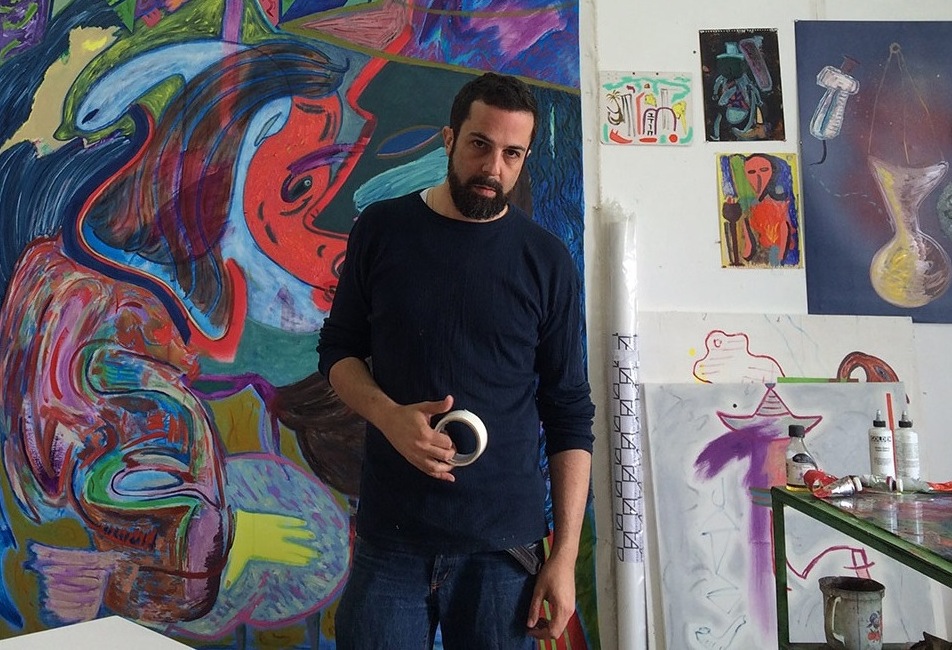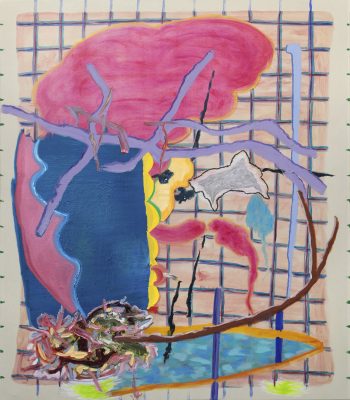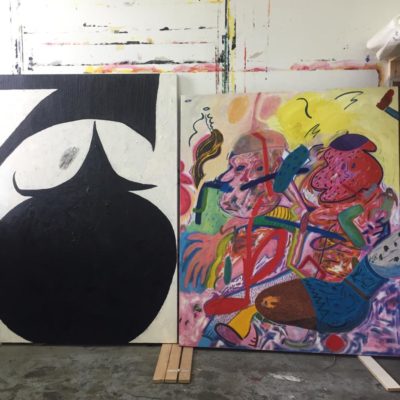Shai Yehezkelli in his studio.
Scroll down to get a glimpse into the studio and the artistic process of an artist who always surprises us!
Shai Yekezkelli works from his studio situated in the industrial Kiryat Hamelacha quarter, located in the south of Tel Aviv, where many studios and galleries can be found. After climbing to the 4th floor of one of the typical brutalist buildings of the area, we reach Yehezkelli’s space, where intuition seems to prevail. The painter doesn’t work with preliminary sketches or photographs but is rather led by the canvas, its limitations and possibilities, and the tensions within the medium of painting itself. In this studio space, Yehezkelli creates paintings in all sizes, using a variety of materials like wood, plastic, and classic linen canvases. We sat down with Yehezkelli to ask him a few questions about his process.
AS: Before we start talking about your actual process, we can’t ignore the strange times we’re living in! How has the pandemic influenced your studio time?
SY: I think the biggest influence was mostly for the first few months of the pandemic, around the lockdown periods. I would sneak out of the home to the studio. There was this tension in the air and a sense that we were going through a defining moment without understanding what was really going on. This all made me reflect and reevaluate the weird position of being an artist, withdrawing to my studio and immersing myself in painting.
AS: How long have you been in your current studio? What drew you to this particular space?
SY: I’ve been working at this studio for 11 years now. What originally drew me to it was the fact that I was very ready to stop working in the same space where I was living. For a while, I tried living and working in the same place, in a dedicated studio area of my apartment, but I very quickly realized that wasn’t working for me. It limited the size of the canvases I was able to work on, I went to sleep breathing turpentine fumes, my work hours spread out across the whole day and night, and I would hardly even leave my home. It became clear that I need to separate the two worlds, that the studio has to be a place I walk to. Having that time on the way allows me to see, think, step away from my home life. That is very important to me.
AS: Another aspect in your work that is hard to miss is the presence of figures painted in profile, they are your self portraits, but are all quite different from each other. Tell us about them.
SY: I’m still working on understanding my own impulse to paint these profiles. What I can say is that this image, along with others that I frequently return to – like the vessel, the boot, the palm tree – emerges at some point through the colors and lines, and demands that I realize it. In that sense each painting is like the Veil of Veronica – the image is there all along and my job is to bring it out.
AS: We know you live and work in the south of Tel Aviv, do you feel the energy of the area infiltrates your work? What is it like to have a studio in this area?
SY: Absolutely. The intensity, the constant sense of urgency, the reminders of people’s hardship – these all infiltrate the studio and my process. I used to think I should try to push all of it away from the creative process; what I really needed was a sterile environment that can detach and elevate from its surroundings. Today I understand that these surroundings are an inspiration that enriches my work.
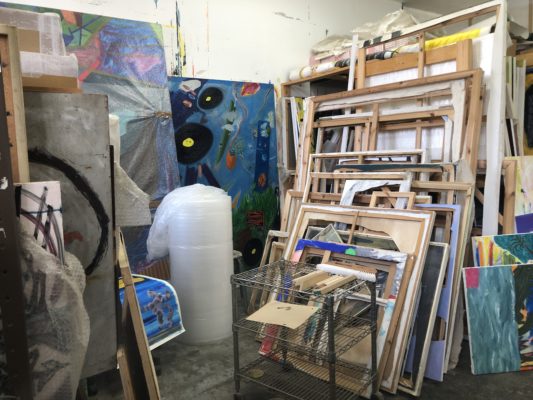
AS: Your education as a child was in a religious school, although you didn’t grow up in a religious home. The motives in your paintings refer to Jewish symbols, like the Jewish errand figure, or your star of redemption series. As someone who is used to navigating between the secular and religious worlds, zooming in and out from them, to what extent do you feel these worlds have had an impact on your work?
SY: I don’t feel that I zoom in and out of these worlds, rather that they coexist in the same world for me. I lived with this intersection as a religious boy and teenager as well. The separation between religious and secular is like the separation between spirit and matter. It only exists if we take the time to point it out. I do wonder sometimes if I would be dealing with the same subject matter if I had taken a different path in life. Possibly. I don’t know.
AS: You work both in large formats and small ones, and both on classical linen canvases and found supports like wood. What is the difference in your mind space when approaching these different scales? How do you choose your canvas both in terms of size and of materials?
SY: I don’t like to work on one type of material or size for a prolonged period of time. Something about getting comfortable with that makes me nervous. Every material reacts to paint differently (and vice versa) and every format or dimension brings out something different in me, requires me to work differently. The body needs to shift its movement, the gaze moves differently. There are so many options for the same two-dimensional cube it’s incredible. How can I not devote myself to it?
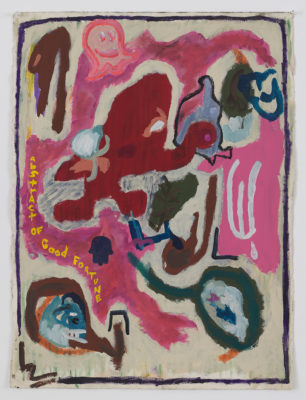
AS: Tell us about your future projects, what are you working on right now?
SY: For the most part I don’t set out working on a specific project, rather I like to work on several paintings simultaneously and see where they take me. This allows me to keep my work dynamic and shift between perspectives. Each time I turn to look at a painting I’m working on I’ll meet two or three other pieces that I’m engaged with at the same time. The current series I’m working on is intended for a three-person show opening in Tel Aviv in a few weeks, which I am really looking forward to.
AS: What are you wishing for yourself in 2022?
SY: To paint more, love more, and approach life courageously.

